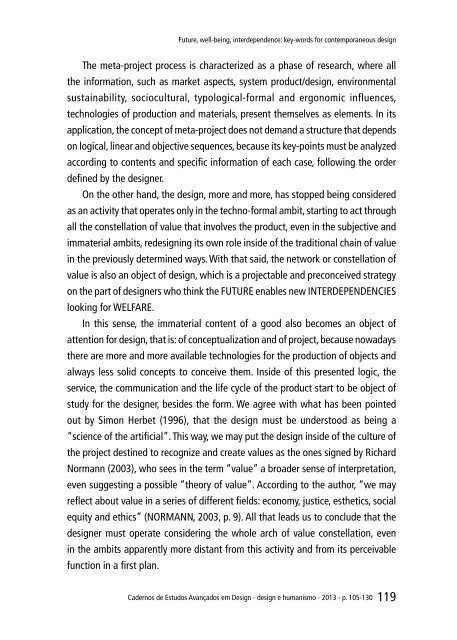o_19po8js951tvs1r0t1r8s4bb1vpla.pdf
Create successful ePaper yourself
Turn your PDF publications into a flip-book with our unique Google optimized e-Paper software.
Future, well-being, interdependence: key-words for contemporaneous design<br />
The meta-project process is characterized as a phase of research, where all<br />
the information, such as market aspects, system product/design, environmental<br />
sustainability, sociocultural, typological-formal and ergonomic influences,<br />
technologies of production and materials, present themselves as elements. In its<br />
application, the concept of meta-project does not demand a structure that depends<br />
on logical, linear and objective sequences, because its key-points must be analyzed<br />
according to contents and specific information of each case, following the order<br />
defined by the designer.<br />
On the other hand, the design, more and more, has stopped being considered<br />
as an activity that operates only in the techno-formal ambit, starting to act through<br />
all the constellation of value that involves the product, even in the subjective and<br />
immaterial ambits, redesigning its own role inside of the traditional chain of value<br />
in the previously determined ways. With that said, the network or constellation of<br />
value is also an object of design, which is a projectable and preconceived strategy<br />
on the part of designers who think the FUTURE enables new INTERDEPENDENCIES<br />
looking for WELFARE.<br />
In this sense, the immaterial content of a good also becomes an object of<br />
attention for design, that is: of conceptualization and of project, because nowadays<br />
there are more and more available technologies for the production of objects and<br />
always less solid concepts to conceive them. Inside of this presented logic, the<br />
service, the communication and the life cycle of the product start to be object of<br />
study for the designer, besides the form. We agree with what has been pointed<br />
out by Simon Herbet (1996), that the design must be understood as being a<br />
“science of the artificial”. This way, we may put the design inside of the culture of<br />
the project destined to recognize and create values as the ones signed by Richard<br />
Normann (2003), who sees in the term “value” a broader sense of interpretation,<br />
even suggesting a possible “theory of value”. According to the author, “we may<br />
reflect about value in a series of different fields: economy, justice, esthetics, social<br />
equity and ethics” (NORMANN, 2003, p. 9). All that leads us to conclude that the<br />
designer must operate considering the whole arch of value constellation, even<br />
in the ambits apparently more distant from this activity and from its perceivable<br />
function in a first plan.<br />
Cadernos de Estudos Avançados em Design - design e humanismo - 2013 - p. 105-130<br />
119



